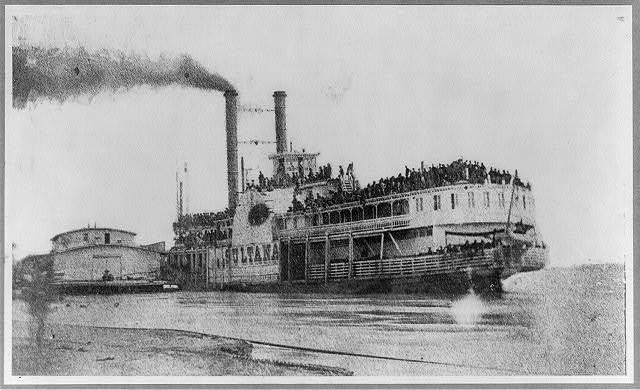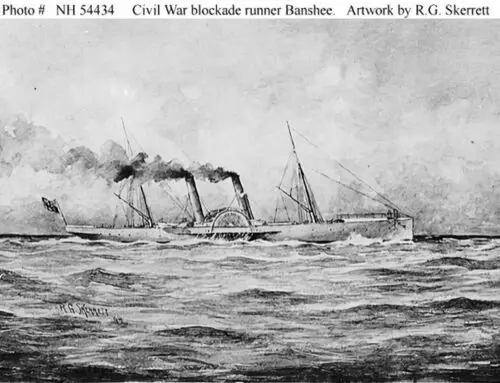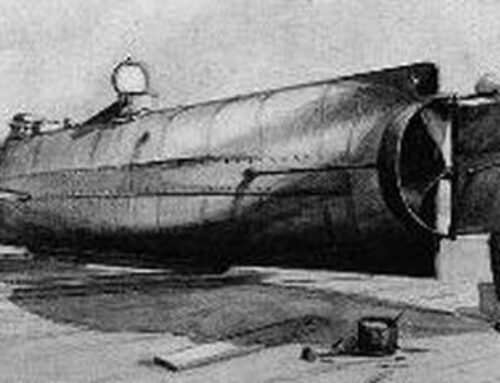The Sultana Ship disaster came at the end of the American Civil War. The Confederate surrender to the Union on April 9th, 1865, was the culmination of four incredibly difficult years for the United States, leaving the nation battered and weary.

The Sultana Ship Disaster – This is a real photograph of the overcrowded Sultana near Helena, Arkansas taken on April 26th 1865. One day before the ship sank in the Mississippi River.
While it was not known how many civilian casualties there were, the military forces on either side of the conflict had a total of at least 620,000 dead, approximately 470,000 wounded, and around 400,000 missing or captured, and a cost of around $5,200,000,000 (about $90,000,000,000 today). The nation was scarred and bruised, and the rebuild would be long and arduous for the country, but it was not prepared for what was to come.
On April 15th, President Abraham Lincoln was attending a performance of “Our American Cousin” at Ford’s Theater in Washington D.C. when he was approached from behind by Confederate actor John Wilkes Booth and shot in the head. Booth evaded capture, leading to a nationwide manhunt for the assassin and a $100,000 bounty for his capture.
For over a week and a half, Booth avoided his pursuers before he and a fellow coconspirator were cornered in a tobacco barn at Richard H. Garrett’s farm in Port Royal, Virginia and killed on April 26th.
Lincoln’s assassination, the hunt for Booth, and his subsequent death captivated the nation’s attention for weeks, drawing focus from any other event in the country. The country, worn, weary, and exhausted by the continual news of tragedy and devastation that ravaged the United States could not take any more bad news.
Lincoln’s death punctuated the finale of the war and Booth’s death ripped focus away and completely overtook from what took place on the Mississippi River the following day on April 27th, 1865.
The S.S. Sultana, a commercial steamboat turned transport, was carrying Union soldiers and civilians North along the Mississippi River when one of its boilers exploded and caused the deadliest maritime disaster in U.S. history.
What Kind of Ship Was the Sultana
The Sultana a wooden steamboat was constructed in Cincinnati, Ohio in 1863 by the John Litherbury Boatyard. The ship was 260-foot-long, 39- to 42-foot-long wide, and weighed 1,719 tons. She had two paddle wheels on her sides and four fire-tube boilers used to power the ship.
As a steamship, she was fast and sturdy with the capacity to carry 376 people along with a significant quantity of cargo. During the war, she had made several profitable runs up and down the Mississippi River from New Orleans to St. Louis, carrying cotton, various other supplies, and soldiers, and participated in races along the river. At the time of the disaster, she was skippered by 34-year-old Captain James Cass Mason.
What Happened to the Sultana
On April 23rd, the Sultana arrived at Vicksburg to pick up their travelers when one of the boiler mechanics noticed a leak in one of the boilers. The crew’s chief engineer, Nathan Wintringer, convinced the mechanic to put a quick patch on the boiler, allowing them to continue their journey unimpeded rather than take further time or money fixing it correctly.
The ship picked up the supplies and passengers, continuing their way to Memphis, Tennessee, but due to their heavy load (over 2,200 people, livestock, and goods), the strain put further pressure on the ship and the boilers. The crew spoke out against the number of people on the ship, but they were ignored.
Docking in Memphis, the Sultana dropped off some wares to lighten their load and finish some further repairs on the boiler. None of the repairs were extensive but allowed the boat to seemingly function well regardless.
The passengers, crammed onto the ship, tried to remain comfortable and deal with the stress of the trip home. On April 26th the same day as the death of Booth, Sultana departed Memphis, traveling between the Arkansas-Tennessee border along the swift Mississippi River.
In the early hours of April 27th, 1865, at around 2:00am, one of the four boilers on the Sultana exploded, which in turn blew up two more of the boilers, sending flowing pillars of fire, billows of steam, burning metal, and shrapnel ripping through the boat.
The blast was so loud it was heard in Memphis, over seven miles away. The explosion ripped a 45° opening into the ship from its hull to the stern, allowing water to start pouring into the boat, pulling the ship down. The ship began to sink as it burned, floating haphazardly down the river, and within a few hours of the explosion, the Sultana sank to the bottom of the Mississippi River near Mound City on the Arkansas-Tennessee border.
For those who were not instantly killed in the explosion, hundreds were thrown into the river or left clinging to the wreckage of the sinking ship. Some found themselves trapped in among the flames while others found the rising water pulling them deeper into the ship. The survivors scrambled to grab pieces of debris to hold onto as the river swept them away, but some of the survivors drowned or succumbed to their injuries shortly after hitting the water.
The survivors still on board the ship battled fire and rising waters, leaving many to risk it all in the river than perish to the flames. Others suffered shock, contusions, burns, scalding, cuts, bruises, and broken bones as they were pitched about by the rapidly flowing dark river.
Panic set in among many of the survivors who clawed at each other or argued over helping others, causing further injuries, anxieties, and death. Jennie A. Perry, a former Union nurse and civilian passenger on the Sultana, leapt into the water after surviving the initial blast wearing a life preserver.
Perry and some soldiers grabbed ahold of a door and while they sped down river, fear and dread set in among all but Perry and a young war hero. Trying to convince the others to remain calm, Perry and the young soldier spoke words of encouragement and consoled the weeping men who, despite being hardened by their time in prison camps and on the battlefield, were now faced with their impending doom.
One of the men, overcome with panic, leapt at Perry, and pulled her underwater several times, pulling on her life preserver. The young soldier who had managed to keep calm, protected Perry, and condemned the frightened man’s cowardice. Eventually, she and the other survivors on the door were rescued by a skiff crew, taking them to Memphis to receive care. Perry survived the ordeal.
The military personnel, most of whom were Union soldiers returning home from Confederate prison camps, were not in the best shape or condition considering what they had been through. Many were sick or wounded, and despite being battle hardened warriors and rugged prisoners of war, they were greatly weakened from their time in the prisons. Those who were not killed in the initial blast were either thrown directly into the river or found themselves trapped on the ship.
One civilian survivor, Ann Annis, had been separated from her husband 2nd Lieutenant Harvey Annis and their daughter while trying to flee the ship. With the help of some of the soldiers on board, she made her way to the rudder and grabbed ahold of it, holding onto it for as long as she could before the flames kicking out from the ship became too much for her, forcing her to let go and fall into the water.
She floated down river for a couple hours until she was rescued by fishermen who were alerted to her perilous situation by her screams. She discovered, while recuperating in the hospital in Memphis, her husband and daughter were lost to the brutal, unforgiving Mississippi River.
Who Was Aboard the Sultana
At the time of the explosion, the Sultana was carrying anywhere between 1,700 to 2,300 people, including 100 civilian passengers, an 85-man crew, 22 guards, and around 1700 to 2,000 Union soldiers, most of whom were released prisoners of war departing from Confederate prison camps.
Some estimates of the number of those on-board range upward of 2,800, although the exact number is not precisely known due to spotty records and some shady dealings. Some of the bodies were never recovered which also made knowing the exact numbers impossible to accurately calculate.
Why Was the Sultana Overcrowded
The reason the Sultana was overloaded with troops was due to one major factor: greed. The young captain, Confederate sympathizer James Cass Mason, was strapped for cash. On April 15th, 1865, upon Mason learning of President Lincoln’s assassination, he bought up newspapers and sailed the ship upriver, delivering the news to the towns and cities along the river’s banks, earning him the moniker “Messenger of Death.” When he arrived in Vicksburg, Mississippi, he was met by Captain Reuben Benton Hatch, the Chief Quartermaster of Vicksburg.
Hatch explained to Mason that because of the conclusion of the war, commanders of ships on the Mississippi River were being paid by the government to transport Confederate and Union troops, particularly those from prisoner of war camps and penitentiaries, back up the river.
Hatch told Mason that the more men the ships carried, the higher the stipend; in exchange for a kickback from Mason’s payment, Hatch would sign off on about 1,000 men on the Sultana. Mason agreed.
When the Sultana came back into port at Vicksburg on April 24th, Hatch revealed on top of the 85-man crew and 100 paying passengers, the Sultana would carry between 1,700 and 2,000 soldiers. This was a direct result of greed, ineptitude, dishonesty, obliviousness, and/or a blatant misunderstanding of the situation on the part of both or either Hatch or Mason.
This was not uncommon; there are several instances of captains of steamships accepting bribes and other kickbacks, taking far more people than their boats could take, leading to a heavy military presence at the ports.
The Sultana grossly exceeded the carrying capacity by at least 1,400 people. Officers and crew members made protests, explaining the danger of having the ship ride so low in the water, tilting, and rocking in the water to a point they were concerned the ship would capsize. They were ignored by the port authorities and other personnel.
Crew members eventually had to plead with the soldiers and civilians they were transporting to remain in their designated areas to help keep the ship steady. Even Captain Mason, who would be the greatest benefactor of the overcrowding as he was paid per man that he brought upriver, knew they had exceeded the possible limit of the steamer and made a complaint. Hatch assured him it would all work out for their benefit. Once everyone had been loaded on board, the ship departed upriver.
Was the Sultana Ever Found
While there are artifacts and fragments of the ship that were recovered from the wreckage, the ship itself was never fully recovered. The river, since its destruction, has naturally been rerouted and shifted, leaving much of the debris from the boat lost to the former riverbeds and fields.
Where is the Wreckage of the Sultana
Parts of the boat have been retrieved but because the river has since been diverted many times over the course of a century and a half, much of the boat has been lost for good. Planks and timber, charred and blackened, pieces of metal from the furnace, and some bricks, have been recovered from neighboring fields and the riverbanks. Pieces that were retrieved have found a home in the Sultana Museum in Marion, Arkansas.
How Many Passengers Died on the Sultana
The most accepted number of those killed, including crew members, civilians, and military passengers, is believed to have been about 1,200 lost, making it the worst maritime disaster in U.S. history.
Scalded corpses, burst bodies, and broken limbs littered the Mississippi River amongst the charred planks of wood and shards of metal illuminated by the burning ship. With the rising sun, hundreds of bodies were recovered from the water by fishermen and rescue boats along with the uninjured and wounded survivors.
One of those lost included Captain Mason himself, who was not injured in the blast. Rushing up on the remaining section of the main deck, Mason helped survivors and the injured off the boat and was last seen throwing planks and boards to survivors from the ship. He was 34 years old at the times of his death; his body was never recovered.
How Many People Survived the Sultana Disaster
The number that would be considered accurate would be around 1,000 total survivors. The exact number of those who survived is not explicitly known due to inconsistent records as to how many had been on board.
What is known is there were around 783 soldiers who survived, although many of the initial survivors died from their injuries or from exposure, adding to the total tally of the dead. They had been pulled out of the water by fishermen and rescue teams and taken to hospitals around Memphis to recuperate from the disaster.
Over two hundred of the initially rescued soldiers died from their injures, leaving around 550 of the original number of soldiers rescued to return home over the coming months.
Was the Sultana Sabotaged
There had been a belief that the ship had been sabotaged by Confederate sympathizers but there has been little evidence to prove this.
What Caused the Sultana to Sink
The Sultana sank as a direct result of the explosion of one of its boilers, which set fire to the main deck and blew a massive hole in the ship. Pieces of boat were strewn across the Mississippi River as the survivors scrambled to escape the flames. The hole in the hull of the ship filled with water as the top of the boat burned above, it sank below. Within five hours of the explosion, the ship sank into the Mississippi River.
Why Did the S.S. Sultana Explode
The Sultana suffered a catastrophic blast as a direct result of a boiler exploding caused by a combination of factors. The weight put on the ship due to the disproportionate number of passengers and goods, placed extraordinary pressure on the boilers, one of which suffered cracks and bulges early on in its journey north up the Mississippi River.
The boiler got a modest and short-term fix rather than a major repair, and the ship, bowing in the water due to the number of passengers, caused the leaking boiler to explode, igniting two of the remaining three boilers to blow up as well.


